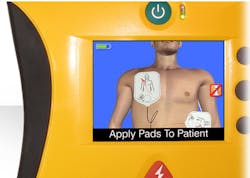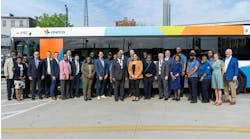On mass transit systems worldwide, automated external defibrillators (AEDs) are becoming an increasingly welcome sight, as transit staff and passengers respond to and save the lives of sudden cardiac arrest victims.
AEDs are now available worldwide on transportation systems serving passengers in locations such as Amsterdam, Boston, Chicago, Dusseldorf, New Jersey, Madrid, Washington, D.C., and Warsaw and on Canadian and French rail. These devices have saved lives by being available in the right place at the right time. However, these devices still remain underutilized on mass transit and elsewhere, leading to 7 million deaths from sudden cardiac arrest each year worldwide. Sudden cardiac arrest is the leading cause of death in the United States, according to the Cleveland Clinic.
More AEDs Could Save Up To 100,000 Additional Lives Each Year
A Johns Hopkins study of more than 13,000 out-of-hospital cardiac arrests published in the Journal of the American College of Cardiology showed that survival increases from a national average of about 8 percent to 38 percent when victims receive AED treatment before EMS arrives. “If more victims had access to defibrillation and we could get the national average to 38 percent survival, this translates to 100,000 additional lives saved each year,” says Mary Newman, the co-founder and president of the Sudden Cardiac Arrest Foundation.
Increasing numbers of mass transit authorities understand the link between AEDs and life saves, one made very clear over the past several years by their counterparts in the airline industry. Since AEDs were mandated by federal law to be onboard flights, AEDs have saved hundreds of lives in the air, as well as inside of airport terminals. For example, the Phoenix Sky Harbor International Airport recently touted its 33rd life save since AEDs were deployed there in 2000. Well over 35 lives have been saved in Chicago airports and 19 in Dublin, Ireland. News reports have told stories about saves in airports in Atlanta, Austin, Boston, Detroit, Duluth, Hawaii, Melbourne, New Orleans, Perth, Pittsburgh, San Diego, Warsaw, and many other places.
As trains and other mass transportation modes begin to match the AED deployment occurring in airliners and airports, similar life save statistics are expected, and saves have already begun to occur. For example, at Boston’s North transit station, three bystanders saved the life of a sudden cardiac arrest victim with an AED placed at the station by the Massachusetts Bay Transportation Authority (MBTA). New Jersey Transit Corp. (NJ Transit) has reported six saves since 2006.
“Automated external defibrillators save lives,” said William Maisel, M.D., deputy director of science and chief scientist at the FDA’s Center for Devices and Radiological Health. The FDA stated that it “will make sure that automated external defibrillators remain available so that they can continue to save lives.”
Public health experts also agree that having AEDs readily available is the best way to reduce sudden cardiac arrest mortality. AED makers foresee business as usual as new FDA regulations are reviewed and established, expressing confidence that any new FDA regulations will be met with devices now in use.
Speed Saves
Experts recognize “speed to shock” as the most important aspect of AED lifesaving. That’s because up to 90 percent of victims receiving AED treatment within two minutes survive, but the chances of survival decrease with each passing minute. By 10 minutes, most die. Therefore, rather than depending on EMS to travel some distance to the scene of sudden cardiac arrest, increasing numbers of mass transit authorities now have AEDs available for use by AED/CPR-trained staff, as well as by untrained bystanders if necessary. The Johns Hopkins study found that “speed is more important than training.” Non-medical volunteers operating AEDs achieved the highest survival rate, followed by healthcare workers and police. “On average, early AED defibrillation before EMS arrival seems to nearly double a victim’s odds of survival after OHCA (out-of-hospital cardiac arrest),” the study’s authors wrote.
To encourage AED use by bystanders, AED manufacturers have been working to make the devices as easy to use as possible — to great success. For example, a University of Washington Medical Center study found that sixth graders took an average time of 90 seconds to perform successful defibrillation on a mannequin, compared to 67 seconds for emergency medical technicians and paramedics. Many organizations and localities offer free or low-cost AED/CPR training opportunities to prepare community members for rescue situations. For example, Marin County (Calif.) EMS offered free, 4-hour AED/CPR training at 16 different locations. Indicative of how easy it is to use an AED, the training was open to anyone age 8 and older.
However, many people still don’t realize how simple AEDs are to use. A survey of 1,000-plus travelers passing through Amsterdam’s central railway station found that about half of them would be willing to use an AED in an emergency. The most common reasons behind the reluctance to use an AED were a lack of knowledge of how to work the AED and concerns about harming the victim. A subsequent survey by AED designer and manufacturer Defibtech and Harris Interactive found that providing AED users with text, audio and video instructions in real-time during a rescue situation would make most respondents more comfortable with using an AED.
Technology: The Solution to Higher SCA Survival
AEDs have come to a tipping point similar to the one that happened several years ago with the introduction of the iPhone. Before Apple launched this product, most consumers were intimidated by smart phones. The iPhone made texting, emailing and Web surfing on smart phones easy and merged it all with music, video, and a world of apps. Many people now manage their lives from their smart phone.
In a similar way, new AED technology has made it possible to merge audio, video, training, and maintenance capabilities into an easy-to-use device that gives confidence to individuals in rescue situations.
For example, the Defibtech Lifeline View AED’s innovative and exclusive HD video feature shows rescuers how to perform each step of an sudden cardiac arrest rescue in real time. Loud and clear audio that can be understood in noisy mass transit environments and corresponding text reinforce the color video. For example, when the View’s audio says and text reads, “Place pads on patient’s chest,” the video shows exactly where to place the defibrillating pads.
The View’s embedded help videos are valuable training resources that help AED-CPR trained transit staff to review the critical steps of a rescue. In addition, the View has a patented status screen that confirms the AED’s readiness for rescue and virtually maintains itself through automated daily self-tests.
Not All AEDs are Created Equal
Choosing an AED that’s easy for bystanders to use is important because not all AEDs are created equal. “The Usability of Five Automated External Defibrillators Used by Minimally Trained Bystanders” study demonstrated significant differences between various AED models — differences in user interface including audio instruction, diagrams, labeling, buttons and indicator lights. The design of these product features affected the ability of study participants to safely deliver an effective and timely defibrillating shock.
Life saves made with AEDs have resulted in favorable public sentiment, which has spawned legislation mandating or encouraging AED placement and protecting Good Samaritans coming to the aid of victims from legal liability. This sentiment also has influenced court decisions recognizing AEDs as a standard of care and assessing damages on organizations that did not have an AED available to help a sudden cardiac arrest victim. These actions and trends have created expectations that AEDs be made available wherever large numbers of people congregate.
It’s now up to all mass transit authorities to follow the AED best practices of their air transportation peers around the world. Placing AEDs in transportation stations and hubs, trains, buses, ferries, and associated parking facilities will save lives and protect the legal and public relations interests of transportation authorities. The alternative is to be unprepared for sudden cardiac arrest — a position carrying the greatest risk of all.
Greg Slusser is a vice president for Defibtech, the designer and manufacturer of the Lifeline and ReviveR families of AEDs and related accessories.




